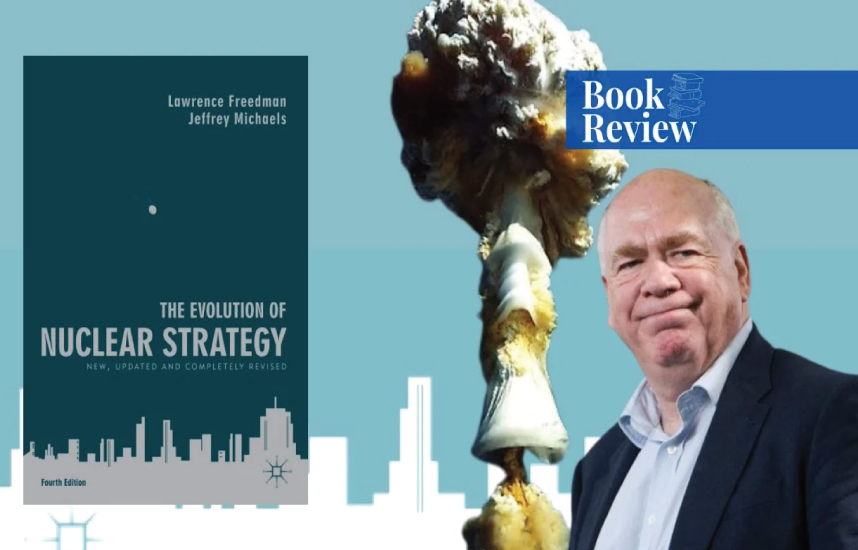“The Evolution of Nuclear Strategy” by Lawrence Freedman, a renowned academic and historian, was first published in 1981. The fourth edition of the book presents different political and regional developments that paved the way for policymakers to come up with different nuclear strategies at different times.
Introduction
“The Evolution of Nuclear Strategy” is a commendable book by Lawrence Freedman. The definitive text on nuclear strategy, first released in 1981, was revised and updated for the fourth edition published in 2019. The new version considerably benefits from significant recent studies and recently made archival information on the development of nuclear policy. More information on the nuclear programs of Israel, India, Pakistan, North Korea, Iraq, and Iran is also included.
The new edition offers a critical analysis of all viewpoints, from abolitionists to those who support building nuclear weapons. It is considered a standard book to trace the political and military convergence on the use of nuclear weapons. It aims to cover the initial four decades of nuclear strategy.
Historical Account
In its first four sections, the author narrates the historical perspective of the nuclear strategy which didn’t evolve as a new or separate concept but rather was developed as an extension of the doctrine of strategic bombardment. Later, due to its technical and strategic limitations, strategic bombing was disregarded as an unsuitable warfare tactic.
There were two different mindsets that contributed to the development of nuclear strategy in the postwar period. On one hand, there were proponents of limited war theory, which was propounded by Sir Basil Henry Liddell Hart. Sir Hart proposed the idea of using an indirect approach to analyze battles and different military campaigns. According to the limited war theory, nuclear weapons should only be used against military targets of the enemy. He also proposed the idea of the tactical use of nuclear weapons.
The other mindset supported the idea of massive retaliation, that even a slight conventional military move by the enemy should be retaliated massively with the help of nuclear weapons. The proponents of massive retaliation had a distaste for building up conventional forces as this had the potential to exhaust the economy of the country by indulging it in an arms race.
America’s Evolution of Nuclear Strategy
Harry S. Truman believed that the need for stronger conventional capabilities was justified by the waning credibility of a nuclear strategy. However, President Dwight D. Eisenhower, who succeeded him, did not believe that a military buildup was tactically or economically required. In a project known as “Solarium,” US strategic alternatives were examined during 1953, Eisenhower’s first year in office.
In a speech to the Council on Foreign Relations in January 1954, Secretary of State John Foster Dulles discussed his findings. Named after women’s fashion trends, the “New Look,” which was later called massive retaliation, was the new doctrine he presented. It was commonly believed that its foundation rested on a blanket threat to counteract any communist threat, no matter how little it seemed. This would include launching a major nuclear attack against the Soviet Union and China’s urban centers.
The Evolution of Nuclear Strategy also gives a historical account of administrative disagreements within the American military establishment regarding the budget for the air force. It was an astounding US strategic debate that emerged in the middle of the 1950s. The army and navy made an effort to reduce the growing percentage of the money that was allotted to strategic air power.
The author further explores how the concept of deterrence carved its place in the minds of policymakers who were concerned with the effective role of nuclear weapons in international politics. Deterrence worked well in the post-war period throughout the world, and it compelled adversaries to avoid war due to the fear of destruction it could cause to the nations. Deterrence helped maintain international order in which countries share their mutual awe and fear of possible annihilation of mankind due to nuclear warfare.
Conclusion
Freedman tries to cover the history of nuclear strategy, but it seems that the author has focused more on the American perspective regarding nuclear strategy, with very little being said or explored in terms of Russian nuclear strategists. Too much emphasis has been given to the bureaucratic element of American nuclear strategy.
In order to summarize the thinking of strategic theorists who came up with different kinds of theories to determine the course of nuclear history, the author has neglected the economical aspects that contributed to the evolution of nuclear strategy.
Without doubting the impartiality of the author, The Evolution of Nuclear Strategy gives the impression that the USSR is responsible for the origin of the cold war and that the US was just countering the USSR to maintain its security through all these strategic theories and policies.
The question of whether using nuclear weapons could advance any worthwhile political goal was also brought up in the book. Undoubtedly, countries developing nuclear strategies had a difficult time coming up with practical nuclear plans that might achieve any worthwhile political goals. Nonetheless, it is an essential work that summarizes the history of nuclear weapons during the cold war.



